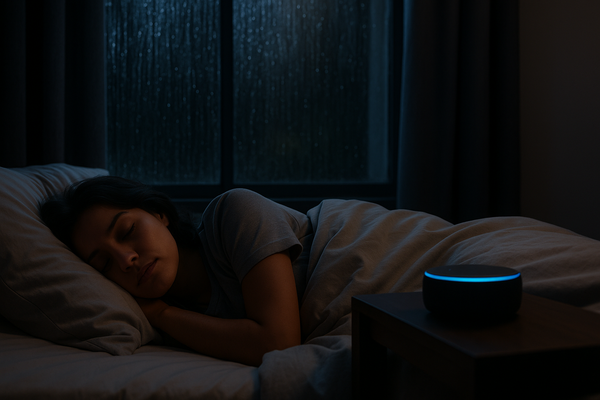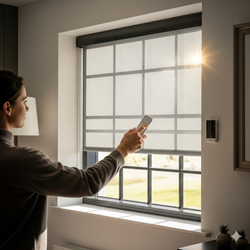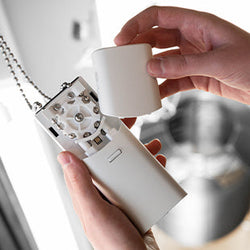What You’ll Learn:
- Why sound can impact sleep quality, focusing on rain, white noise, and brown noise.
- The science behind why some people sleep better with noise and others prefer silence.
- Other effective sleep techniques such as room temperature, air quality, and routine.
- How to build a sleep environment tailored to your unique needs.
Why Sound Matters for Sleep
When your brain hears soft, consistent sounds, like gentle rainfall, ocean waves, or rustling leaves, it interprets them as non-threatening. These types of sounds can lower your heart rate, ease anxious thoughts, and create a sense of calm. They also help mask sudden or jarring noises (like traffic, barking dogs, or noisy neighbors) that might otherwise wake you up or prevent you from falling asleep in the first place.
Different types of sound do different things for the brain:
- Rain sounds offer a rhythmic, natural white noise that many people associate with comfort and coziness. They don’t demand your attention — they gently lull you.
- White noise is a steady, static-like sound that plays all audible frequencies equally. It helps create a consistent background that can drown out disruptions.
-
Brown noise, which emphasizes deeper, bass-like tones, tends to feel warmer and softer. It’s often described as more soothing for the nervous system.
When these sounds are used intentionally — as part of a bedtime routine — they can signal to the brain that it’s time to wind down. Like a lullaby for adults.
Why Some People Need Noise, and Others Prefer Silence
Ever wonder why one person can fall asleep with a podcast humming in the background, while another needs complete silence to even begin winding down? It comes down to how our brains are wired, what we associate with rest, and even how sensitive we are to sensory input.
Some people find background noise comforting. It gives their busy brain something to focus on gently, like a soft distraction that quiets racing thoughts. Others grew up falling asleep to the TV or familiar household sounds, so background noise feels like “home” to their nervous system. For them, silence might actually feel too still or too loud in its own way.
But others find noise overstimulating. Even soft sounds might trigger alertness instead of relaxation. These people tend to sleep better in a quiet room: ideally one that’s cool, dark, and still. For them, sound can be a reminder that the world is still moving when all they want is stillness.
And both preferences are totally valid.
The key is to tune into what works best for you. If sound helps you drift off, embrace it. If it keeps you awake, there’s nothing wrong with craving a soundless sleep environment. Your sleep space should be shaped around your comfort, not trends or what works for someone else.
What Other Techniques Can Improve Your Sleep Environment?
Sound is just one piece of the sleep puzzle. If you’re serious about getting better rest, your sleep environment deserves some extra love. Small changes can make a big difference — and many are easier than you think.
Darkness matters. Light, especially blue light, tells your brain it’s time to stay alert. Whether it’s streetlights through the window or that blinking light on a charger, even a little glow can interfere with your sleep cycle. Blackout curtains, sleep masks, or smart shades like RYSE can help create that soothing darkness your body craves at night — and gently let light in when it’s time to wake up.
Temperature plays a big role, too. Cooler rooms promote deeper, uninterrupted sleep. Experts recommend keeping your bedroom around 60–67°F (15–19°C). It’s easier for your body to fall and stay asleep when it’s not overheating.
Clean air counts. Dust, allergens, and poor air circulation can irritate your sinuses and disrupt breathing while you sleep. Keeping windows open when possible, using an air purifier, and regularly changing bedding all contribute to a more restful space.
Sleep hygiene isn’t about perfection. It’s about creating an environment that supports rest and makes it easier for your body to do what it’s naturally designed to do: relax, restore, and reset.
You Don’t Have to Follow Every Trend — Just Listen to Your Body
It’s easy to feel overwhelmed by all the sleep advice out there. One day it’s white noise, the next it’s magnesium supplements or mouth taping. While some trends are backed by research and others are just hype, the truth is this: you don’t have to do everything. You just have to do what works for you.
Some people fall asleep to the sound of rain or a favorite podcast. Others need total silence. Some swear by a cold room, while others sleep best with a window cracked open. There’s no universal formula, and that’s okay.
The most effective sleep routine is one that’s consistent, calming, and tailored to your own rhythms. That might mean experimenting a bit, paying attention to how you feel in the morning, and adjusting as you go. Trust that your body has wisdom — and your job is to support it, not force it.
And when you find tools that do work for you, like RYSE smart shades for managing light or a sound machine that mimics rain, lean in. Let them become small rituals in your nighttime routine. Over time, those simple choices can lead to deeper sleep, better mornings, and a body that feels truly restored.
Let RYSE Support Your Sleep Routine
Building a healthy sleep routine means designing your space to support rest — and that includes how and when light enters your room. With RYSE SmartShade and RYSE SmartCurtain, you can automate your environment to match your natural rhythms. Wake up gently with natural sunlight or block out light completely for uninterrupted sleep. These devices install easily, even in rentals, and work with your favorite smart home systems. Whether you're an early riser or a night owl, RYSE helps you stay in sync with your body.
FAQ
Why does rain sound help some people sleep?
Rain sound, along with other types of white, pink, or brown noise, creates a consistent background that masks sudden changes in sound. This makes it easier for your brain to stay calm and uninterrupted, helping you fall and stay asleep.
Why can some people sleep through noise, and others can’t?
Sleep sensitivity varies. Genetics, stress levels, and past sleep habits all play a role. Some people need total silence to feel safe and settled, while others find gentle noise reassuring. There’s no “right” way: just what works for your body.
What if rain sounds don’t help me sleep?
That’s completely okay. Try other cues like a cooler room, blackout curtains, an air purifier, or a calming bedtime routine. Sleep is personal — the goal is to build a space and habit that feels right for you.
How can RYSE help me sleep better?
RYSE SmartShade and SmartCurtain help you control light effortlessly. Block out city lights at bedtime, or wake naturally with morning sun. Whether you use white noise, total darkness, or both, RYSE gives you control over your sleep environment — even from bed.
How do RYSE SmartShade and SmartCurtain work?
Both devices are designed to automate your existing window coverings. Once installed, you can control them via app, voice commands, or set schedules — even when you’re not home. It’s a hands-free way to manage light and privacy without needing a full smart home setup.
What types of curtains and shades are compatible with RYSE?
RYSE SmartShade works with beaded chain shades (like roller, roman, or zebra shades) and lifts shades up to 10 lbs with ease, while RYSE SmartCurtain is made for curtains with grommet, ring, or pinch pleat headers that slide along a curtain rod. No need to replace your window treatments — just make them smarter.









